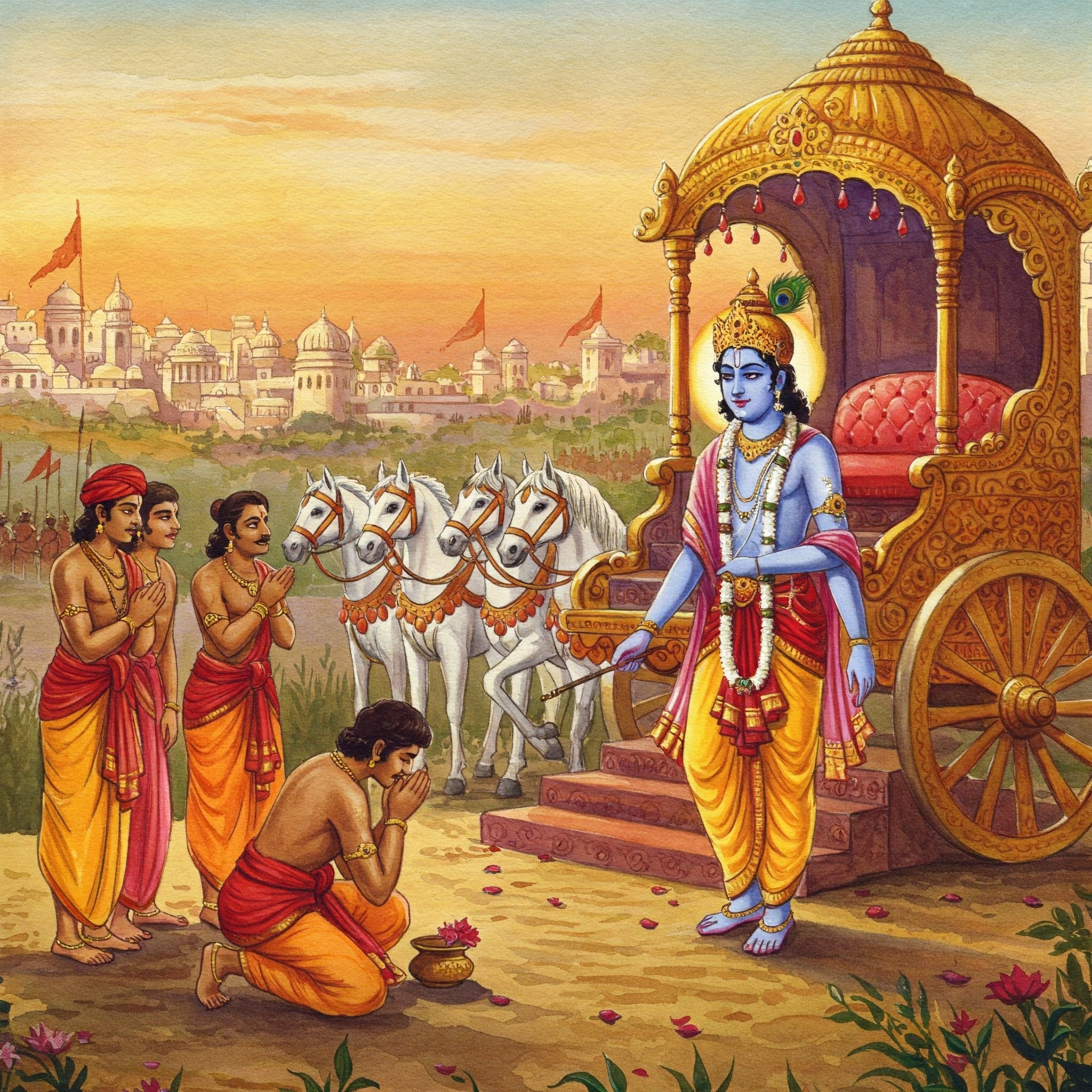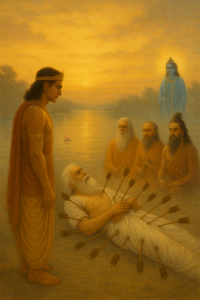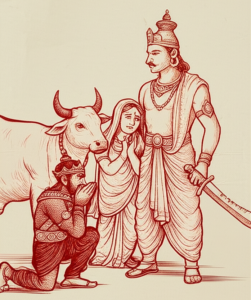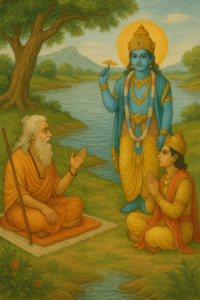In today’s world of constant hustle, fleeting victories, and deep uncertainties, have you ever paused to ask: what truly matters? This ancient story begins after the devastating Kurukshetra war, imagine standing amidst the ruins of the Kurukshetra war—a battlefield that reshaped destinies and tore families apart, King Yudhisthira rebuilds a kingdom grounded in Dharma. Yet, even amidst triumph, the void of Shree Krishna’s departure and the wisdom of Vidura remind us of life’s impermanence and the need to transcend attachments.
Just like us today, these characters faced loss, ambition, and the quest for purpose. Their journey offers timeless insights on letting go, embracing change, and finding peace beyond material pursuits. Are you curious to discover how these ancient stories hold the key to unlocking balance and clarity in your modern life?
The Cycles of Dharma
After the harrowing conclusion of the Kurukshetra war, King Yudhisthira ascended the throne of Hastinapur. Determined to restore peace, he ruled with the principles of Dharma as his foundation, ensuring that every living being within his realm thrived without suffering. The scars of the war lingered, but his leadership provided solace to his people.
As order returned to the kingdom, Shree Krishna prepared to leave for Dwarka. His departure left a profound void in Hastinapur. The Pandavas, along with their family—Subhadra, Draupadi, Kunti, Uttara, Gandhari, and Dhritarashtra—were overcome with sorrow, reluctant to let him go. However, Shree Krishna reminded them that life’s purpose must transcend attachments.
With mridangas, veenas, and dhols echoing a heartfelt farewell, and amidst a shower of flowers, the Shree Krishna departed. On reaching the gates of Dwarka, Krishna blew his conch shell, Panchajanya, its resonance signalling his return to the city. Dwarka erupted in joy. Krishna’s parents, wives, sons, and all its residents embraced him with uncontainable happiness.
Meanwhile, in Hastinapur, new life breathed fresh hope into the Pandavas’ legacy. Parikshit, the son of Abhimanyu and Uttara, was born. The child glowed with the radiance of his ancestry, as if Pandu himself had been reborn. The joyous Yudhisthira celebrated Parikshit’s birth with grand rituals, distributing gold, food, and blessings to his subjects. The child, blessed by Lord Vishnu in his mother’s womb during the terrible Brahmastra assault, was named Vishnurat—protected by Vishnu.
Parikshit’s destiny, as revealed by the Brahmins, was extraordinary. He was to uphold Dharma in a world shadowed by the emerging age of Kali. However, fate’s whisper also foretold a tragic curse—his eventual demise through a sage’s wrath. Yet Yudhisthira chose to focus on his duties, immersing himself in sacrificial yagnas and governance, striving to cleanse the stain of the war from his soul.
Vidura’s Return: A Reminder of Impermanence
The Pandavas became engrossed in their worldly pursuits, unmindful of life’s fleeting nature. Vidura, who had been on a spiritual pilgrimage, returned to Hastinapur after acquiring the wisdom of the soul from sage Maitreya. His presence was like a breath of fresh air for Dhritarashtra, Kunti, Gandhari, and the Pandavas. But Vidura came not only to reunite but to deliver a profound message.
Vidura reminded Dhritarashtra of life’s impermanence. “Great king,” he said, “you have lived through the agony of loss and seen the futility of attachment. The time has come to detach from the material world and seek spiritual liberation.” With Vidura’s urging, Dhritarashtra, accompanied by Gandhari, left for the forest to embrace a life of renunciation.
The morning after their departure, Yudhisthira discovered their absence and was gripped by worry. Narada Muni arrived to console him. “Do not grieve,” the sage advised. “Life and death, joy and sorrow—these are but waves in the vast ocean of existence, directed by the divine will. Dhritarashtra and Gandhari have chosen a path of liberation. Their mortal end, through fire in the forest, will elevate their souls to divine realms.”
A Lesson in Impermanence
Narada Muni’s words planted a seed of realization in Yudhisthira’s heart. The sage cautioned him that change was inevitable, and even the golden age of the Pandavas would soon give way to the trials of time. The cycle of Dharma had to continue.
Indeed, Dhritarashtra and Gandhari perished peacefully, united in their departure. Vidura, his soul fulfilled after guiding his brother, resumed his pilgrimage, while Narada Muni ascended to higher planes, leaving Yudhisthira to contemplate the ebb and flow of existence.
Conclusion: The Timeless Relevance of Detachment
The tale of Dhritarashtra, Gandhari, and the Pandavas mirrors life today. In a world consumed by material pursuits, we often forget the ephemeral nature of wealth, power, and relationships. Vidura’s advice reminds us of the need for introspection and spiritual detachment. In modern terms, this translates to finding balance amidst ambition, knowing when to let go, and understanding that peace lies within, not in external possessions.
The inevitability of change teaches us to cherish the present while preparing for the future with humility. Through this story, we discover that amidst joy and sorrow, triumph and loss, it is our alignment with Dharma that guides us to the ultimate truth: life is but a fleeting bridge to eternal consciousness.



